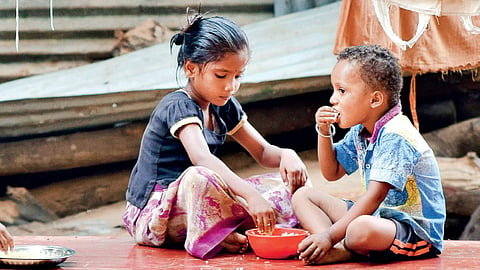

AHMEDABAD: In Gujarat, despite the Government of India allocating Rs 2,879.3 crore under Poshan Abhiyaan over the past three years, malnutrition and health challenges persist.
As of October 2024, government data presented in the Rajya Sabha reveals that 40.8 per cent of children aged 0-5 years are stunted, 7.8 per cent are wasted, and 21 per cent are underweight.
Additionally, 65 per cent of women aged 15-49 years are battling anaemia.
The Ministry of Women and Child Development revealed significant funding details under the Poshan Abhiyaan-National Nutrition Mission (NNM) in the Rajya Sabha on Wednesday.
Responding to a query by MP Dr. V. Sivadasan, the ministry reported that the Central Government allocated Gujarat, Rs 839.86 crore in 2021-22, Rs 912.64 crore in 2022-23, and Rs 1,126.8 crore in 2023-24 under Mission Poshan 2.0 to address malnutrition.
The data highlights a steady increase in budgetary allocations over the past three years, reflecting the government's intensified efforts to tackle nutritional challenges nationwide.
However, Government data reveals a steady decline in beneficiaries under the "Poshan Abhiyaan-NNM" scheme over the past three years in Gujarat.
In 2021-22, the program reached 42,87,408 beneficiaries, which dropped to 40,47,017 in 2022-23 and further decreased to 37,82,803 by March 2024 in Gujarat.
Despite significant government spending to combat malnutrition, its severe impact remains evident in Gujarat, highlighting a pressing concern.
The Government of India informed the Rajya Sabha that malnutrition rates in Gujarat As of October 2024, 40.8 per cent of children aged 0-5 years are stunted, 7.8 per cent are wasted, and 21 per cent are underweight.
In comparison, the 2022 figures were higher, with 53.6 per cent stunted, 8.1 per cent wasted, and 23.1 per cent underweight.
However, Anemia remains a significant concern in Gujarat, with 65 per cent of women aged 15-49 years affected, highlighting the widespread prevalence of the condition.
While the government has significantly increased budget allocations under Mission Poshan 2.0 to combat malnutrition, Gujarat faces persistent challenges. Improvements in malnutrition rates among children indicate progress, yet the high prevalence of anaemia among women and a steady decline in beneficiaries suggest gaps in outreach and program impact.
The data underscores the need for targeted interventions to ensure the funds translate into tangible health outcomes.